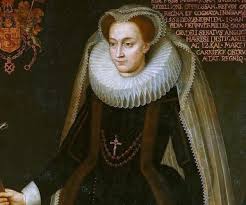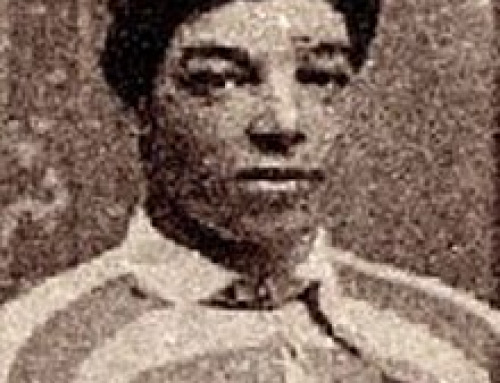Mary, Queen of Scots is perhaps the best known figure in Scotland’s royal history. Her life provided tragedy and romance, more dramatic than any legend She was born on the 8th December 1542 Mary was six days old when her father died and she acceded to the throne.
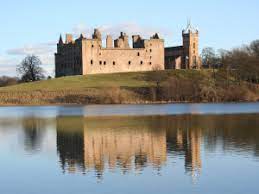
She was born at Linlithgow Palace, Scotland, to King James V and his French second wife, Mary of Guise. She was said to have been born prematurely and was the only legitimate child of James to survive him. She was the great-niece of King Henry VIII of England, and her paternal grandmother Margaret Tudor, was Henry VIII’s older sister. On 14 December 1542 just six days after her birth, she became Queen of Scotland when her father died, perhaps from the effects of a nervous collapse following the Battle of Solway Moss either that or from drinking contaminated water while on campaign. During childhood, Scotland was governed by regents, first by the heir to the throne, James Hamilton, Earl of Arran, and then by her mother, Mary of Guise. King Henry VIII of England took the opportunity of the regency to propose marriage between Mary and his own son and heir, Edward, hoping for a union of Scotland and England. On 1 July 1543, when Mary was six months old, the Treaty of Greenwich was signed, which promised that, at the age of ten, Mary would marry Edward and move to England, where Henry could oversee her upbringing The treaty provided that the two countries would remain legally separate and, if the couple should fail to have children, the temporary union would dissolve. Cardinal Beaton rose to power again and began to push a pro-Catholic pro-French agenda, angering Henry, who wanted to break the Scottish alliance with France Beaton wanted to move Mary away from the coast to the safety of Stirling Castle. Regent Arran resisted the move, but backed down when Beaton’s armed supporters gathered at Linlithgow. The Earl of Lennox had to escort Mary and her mother to Stirling on 27 July 1543 with 3,500 armed men. Mary was crowned in the castle chapel on 9 September 1543.
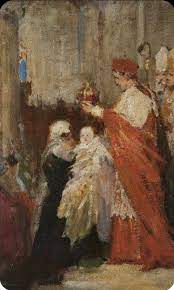
Shortly before Mary’s coronation, Henry arrested Scottish merchants headed for France and impounded their goods. The arrests caused anger in Scotland, and Arran joined Beaton and became a Catholic. The Treaty of Greenwich was rejected by the Parliament of Scotland in December. The rejection of the marriage treaty and the renewal of the alliance between France and Scotland prompted Henry’s “Rough Wooing”, a military campaign designed to impose the marriage of Mary to his son. English forces mounted a series of raids on Scottish and French territory. Then in late May 1544, the then English Earl of Hertford (later Duke of Somerset) raided Edinburgh, and the Scots took Mary north to Dunkeld for her own safety. In 1548, she was then betrothed to Francis, the Dauphin of France, and was sent to be brought up in France, where she would be safe from any of the invading English forces during the Rough Wooing. With her marriage agreement in place Mary spent the next thirteen years at the French court. The French fleet sent by Henry II, that was commanded by Nicolas de Villegagnon, sailed with Mary from Dumbarton on 7 August 1548 and arrived a week or more later at Roscoff or Saint-Pol-de-Léon in Brittany. Mary was accompanied by her own court which included two illegitimate half-brothers, and the very famous “four Marys” (four girls her own age, all named Mary), who were the daughters of some of the noblest families in Scotland: Beaton, Seton, Fleming, and Livingston. They in there own right have become synonymous with Mary and feature in most of the events throughout Marys life, both good and bad.
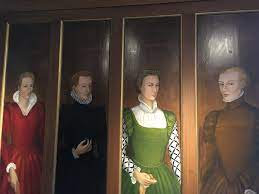
Mary married Francis in 1558, becoming Queen consort of France from his accession in 1559 until his death in December 1560. Widowed, Mary returned to Scotland in August 1561. Following the Scottish Reformation, the tense religious and political climate that Mary encountered on her return to Scotland was further agitated by prominent Scots such as John Knox, who openly questioned whether her subjects had a duty to obey her. King Francis II died on 5 December 1560 of a middle ear infection that led to an abscess in his brain. Mary was grief-stricken. Her mother-in-law, Catherine de’ Medici, became regent for the late king’s ten-year-old brother Charles IX, who inherited the French throne. Mary returned to Scotland nine months later, arriving in Leith on 19 August 1561. Having lived in France since the age of five, Mary had little direct experience of the dangerous and complex political situation in Scotland. As a devout Catholic, she was regarded with suspicion by many of her subjects, as well as by the Queen of England. Scotland was torn between Catholic and Protestant factions. Mary’s illegitimate half-brother, the Earl of Moray, was a leader of the Protestants. The then Protestant reformer John Knox preached against Mary, condemning her for hearing Mass, dancing, and dressing too elaborately. She summoned him to her presence to remonstrate with him but was unsuccessful. She later charged him with treason, but he was acquitted and released To the surprise and dismay of the Catholic party, Mary tolerated the newly established Protestant ascendancy, and she still kept her half-brother Moray as her chief advisor Her privy council of 16 men, appointed on 6 September 1561, retained those who already held the offices of state. The council was dominated by the Protestant leaders from the reformation crisis of 1559–1560: the Earls of Argyll, Glencairn, and Moray. However only four of the councillors were Catholic: the Earls of Atholl, Erroll, Montrose, and Huntly, who was also the Lord Chancellor. Modern historian Jenny Wormald found this remarkable and suggested that Mary’s failure to appoint a council sympathetic to Catholic and French interest’s was an indication of her focus on the English throne, over the internal problems of Scotland. Even the one significant later addition to the council, Lord Ruthven in December 1563, was another Protestant whom Mary personally disliked. In this, she was acknowledging her lack of effective military power in the face of the Protestant lords, while also following a policy that strengthened her links with England. She joined with Moray in the destruction of Scotland’s leading Catholic magnate, Lord Huntly, in 1562, after he led a rebellion against her in the Highlands. The early years of her personal rule were marked by pragmatism, tolerance, and some moderation. She issued a proclamation accepting the religious settlement in Scotland as she had found it upon her return, retained advisers such as James Stewart, Earl of Moray, and William Maitland of Lethington, and she governed as the Catholic monarch of a Protestant kingdom.
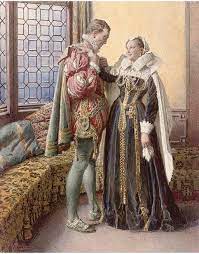
Mary then became married to her half cousin, Henry Stuart, Lord Darnley, in 1565, Mary’s marriage to a leading Catholic precipitated Mary’s half-brother, the Earl of Moray, to join with other Protestant lords, including Lords Argyll and Glencairn, in open rebellion. Mary set out from Edinburgh on 26 August 1565 to confront them. On the 30th, Moray entered Edinburgh but left soon afterward, having failed to take the castle. Mary returned to Edinburgh the following month to raise more troops. In what became known as the Chaseabout Raid, Mary with her forces and Moray with the rebellious lords roamed around Scotland without ever engaging in direct combat. Mary’s numbers were soon boosted by the release and restoration to favour of Lord Huntly’s son and the return of James Hepburn, 4th Earl of Bothwell, from exile in France. Unable to muster sufficient support, Moray left Scotland in October for asylum in England. Mary broadened her privy council, bringing in both Catholics (Bishop of Ross John Lesley and Provost of Edinburgh Simon Preston of Craigmillar) and Protestants (the new Lord Huntly, and the Bishop of Galloway Alexander Gordon, John Maxwell of Terregles and Sir James Balfour). Before long, Darnley grew arrogant, not content with his position as king consort, he demanded the Crown Matrimonial, which would have made him a co-sovereign of Scotland with the right to keep the Scottish throne for himself, if he outlived his wife. Mary refused his request and their marriage grew strained, He was also jealous of her friendship with her Catholic private secretary, David Riccio, so he, together with others, murdered Riccio in front of Mary in Holyrood House. She was six months pregnant at the time.
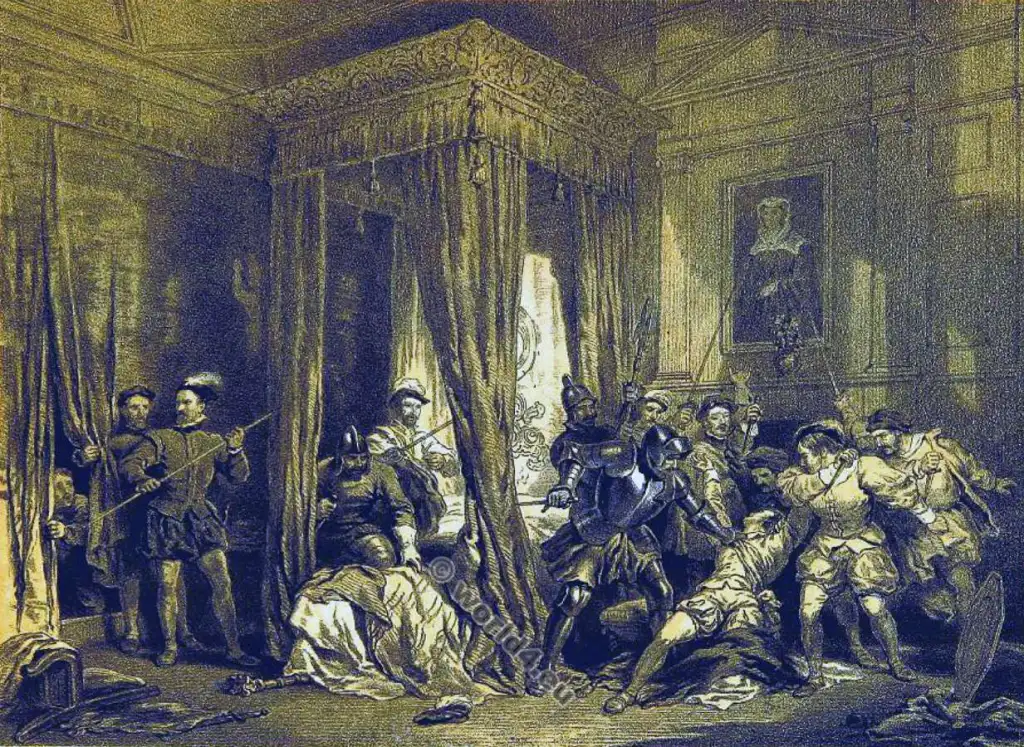
Then in June 1566, they had a son, James. Mary’s son by Darnley, James, was born on 19 June 1566 in Edinburgh Castle. However, the murder of Rizzio led to the breakdown of her marriage. However in October 1566, while staying at Jedburgh in the Scottish Borders, Mary made a journey on horseback of at least four hours each way to visit the Earl of Bothwell at Hermitage Castle, where he lay ill from wounds sustained in a skirmish with border reivers. The ride was later used as evidence by Mary’s enemies that the two were lovers, though no suspicions were voiced at the time and Mary had been accompanied by her councillors and guard In February 1567 Her son, the future King James VI of Scotland and I of England, was baptised in the Catholic faith in Stirling Castle. This caused alarm amongst the Protestants, Darnley’s residence was destroyed by an explosion, and he was found murdered in the garden. Mary had now become attracted to James Hepburn, Earl of Bothwell, and rumours abounded at Court that she was pregnant by him. Bothwell was accused of Darnley’s murder but was found not guilty. Shortly after he was acquitted, Mary and Bothwell were married. The Lords of Congregation did not approve of Mary’s liaison with Bothwell and she was imprisoned in Leven Castle where she gave birth to still-born twins. Bothwell meanwhile had bid Mary goodbye and fled to Dunbar. She never saw him again. He died in Denmark, insane, in 1578 On 24 July 1567, she was forced to abdicate in favour of her one-year-old son. After an unsuccessful attempt to regain the throne when in May 1568 Mary escaped from Leven Castle.
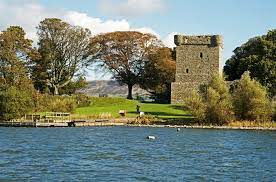
She then gathered together a small army of her supporters but was defeated at Langside by the Protestant faction, she fled southward seeking the protection of her first cousin once removed, Elizabeth I of England. (Elizabeth who was the granddaughter of Henry VII of England, and Mary was his great-granddaughter.) After spending the night at Dundrennan Abbey, she then crossed the Solway Firth into the North of England by a small fishing boat on 16 May. She was landed at Workington in Cumberland in the north of England and stayed overnight at Workington Hall. On 18 May, local officials took her into protective custody at Carlisle Castle Mary apparently expected Elizabeth to help her regain her throne Elizabeth was cautious, ordering an inquiry into the conduct of the confederate lords and the question of whether Mary was guilty of Darnley’s murder. In mid-July 1568, English authorities moved Mary to Bolton Castle, because it was further from the Scottish border but not too close to London . Mary’s clothes, sent from Loch Leven Castle, arrived on 20 July. A commission of inquiry, or conference, as it was known, was held in York and later Westminster between October 1568 and January 1569 In Scotland, her supporters fought a civil war against Regent Moray and his successors. On 26 January 1569, Mary was moved to Tutbury Castle and placed in the custody of the Earl of Shrewsbury and his formidable wife Bess of Hardwick. Elizabeth considered Mary’s designs on the English throne to be a serious threat and so had her confined to all of her Shrewsbury’s properties, which included, Tutbury, Sheffield Castle, Sheffield Manor Lodge, Wingfield Manor, and Chatsworth House all located in the interior of England, halfway between Scotland and London and distant from the sea. Mary was permitted her own domestic staff, which never numbered fewer than 16 She needed 30 carts to transport her belongings from house to house Her chambers were decorated with fine tapestries and carpets, Her bedlinen was changed daily, and her own chefs prepared meals with a choice of 32 dishes served on silver plates She was very occasionally allowed outside and only under strict supervision, spent seven summers at the spa town of Buxton, and spent much of her time doing embroidery. Her health had declined slowly, perhaps through porphyria or lack of exercise, and by the 1580s, she suffered from severe rheumatism in her limbs, rendering her lame. In May 1569, Elizabeth attempted to mediate the restoration of Mary in return for guarantees of the Protestant religion, but a convention held at Perth rejected the deal overwhelmingly. Norfolk continued to scheme for a marriage with Mary, and Elizabeth imprisoned him in the Tower of London between October 1569 and August 1570.
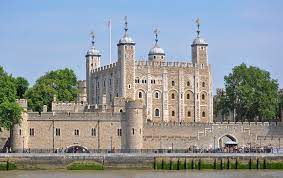
Early the following year, Moray was assassinated. His death coincided with a rebellion in the North of England, led by Catholic earls, which persuaded Elizabeth that Mary was a threat. English troops intervened in the Scottish civil war, consolidating the power of the anti-Marian forces. Most of Elizabeth’s principal secretaries including Sir Francis Walsingham and William Cecil, Lord Burghley, watched Mary carefully with the aid of spies placed in her household. In 1571, Cecil and Walsingham uncovered the Ridolfi Plot, a plan to replace Elizabeth with Mary with the help of Spanish troops and the Duke of Norfolk. Norfolk was executed and the English Parliament introduced a bill barring Mary from the throne, to which Elizabeth refused to give royal assent. To discredit Mary, the casket letters were published in London. Plots centred on Mary continued. Pope Gregory XIII endorsed one plan in the latter half of the 1570s to marry her to the governor of the Low Countries and illegitimate half-brother of Philip II of Spain, John of Austria, who was supposed to organise the invasion of England from the Spanish Netherlands. After the Throckmorton Plot of 1583, Walsingham introduced the Bond of Association and the Act for the Queen’s Safety, which sanctioned the killing of anyone who plotted against Elizabeth and aimed to prevent a putative successor from profiting from her murder In 1584, Mary proposed an “association” with her son, James. She announced that she was ready to stay in England, to renounce the Pope’s bull of excommunication, and to retire, abandoning her pretensions to the English Crown. She also offered to join an offensive league against France. For Scotland, she proposed a general amnesty, agreed that James should marry with Elizabeth’s knowledge, and accepted that there should be no change in religion. Her only condition was the immediate alleviation of the conditions of her captivity. James went along with the idea for a while, but eventually rejected it and signed an alliance treaty with Elizabeth, abandoning hismother. Elizabeth also rejected the association because she did not trust Mary to cease plotting against her during the negotiations in February 1585, William Parry was convicted of plotting to assassinate Elizabeth, without Mary’s knowledge, although her agent Thomas Morgan was implicated. In April, Mary was placed in the stricter custody of Sir Amias Paulet . At Christmas, she was moved to a moated manor house at Chartley. Despite the fact that she was the sovereign queen of another country, Mary was tried by an English court and condemned; her son, James, who had not seen his mother since infancy and now had his sights fixed on succeeding to the English throne, raised no objections. Mary was executed in 1587 in the great hall at Fotheringhay Castle, near Peterborough; she was 44 years old. It was a chilling scene, redeemed by the great personal dignity with which Mary met her fate. It is said that after her execution, when the executioner raised the head for the crowd to see, it fell and he was left holding only Mary’s wig. However according to at least one eyewitness, her little dog had been hidden in the voluminous folds of her dress and was discovered covered in its mistress’s blood and in a state of great agitation. He wouldn’t leave her body. At the end of her life, it seems that Mary still had at least one loyal friend. Mary was intially buried at nearby Peterborough Cathedral. Her body ultimately came to rest in a tomb in Westminster Abbey
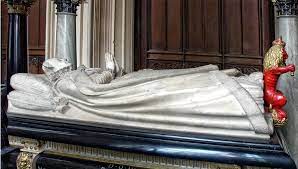
A romantic and tragic figure to her supporters, a scheming adulteress if not murderess to her political enemies, Mary aroused furious controversy in her own lifetime, during which her cousin Queen Elizabeth aptly termed her “the daughter of debate.” Her dramatic story has continued to provoke argument among historians ever since, while the public interest in this 16th-century femme fatale remains unabated.
